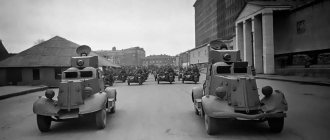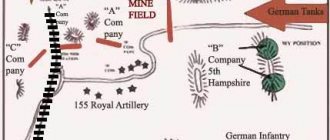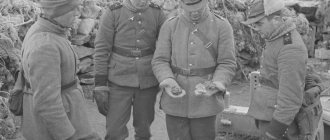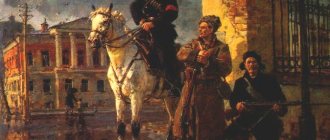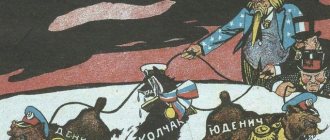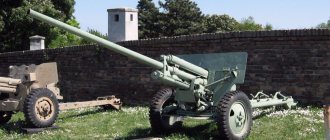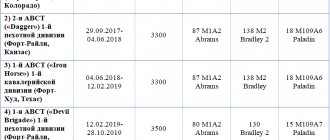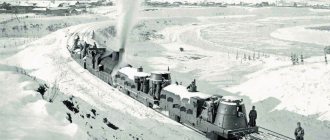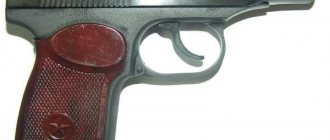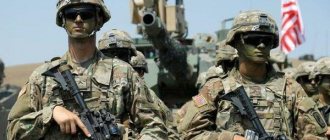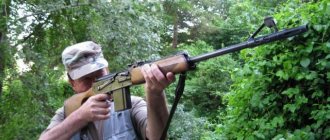This fighting vehicle is perhaps the most famous tank of Nazi Germany. Not everyone will remember the Pz.IV, which went through the entire war, but tanks with “cat” names are known everywhere. At the same time, the Pz.V also gained a reputation as the most controversial tank of the Reich.
While the “Tiger” remained in memory as an indestructible, formidable weapon, the “Panther” gained a reputation as a potentially powerful tank, but in fact, capricious and unreliable. It never became the main tank of the Panzerwaffe, and hopes that it could play a decisive role in some battles were never realized.
History of creation
Before the attack on the Soviet Union, the basis of the armored forces of the Third Reich were medium tanks Pz.35(t), Pz.38(t) and Pz.III and IV. They proved to be quite good machines, agile and reliable. But after the battles with the French B-1s and British Matildas, it was obvious that their weapons were ineffective in the fight against projectile armor. There was no doubt about the insufficient security of German vehicles.
The Germans knew about the presence of heavy KV tanks in the Soviet Union. But in 1941 it was still possible to take a risk and try to repeat the blitzkrieg, based on hopes for a small number of such vehicles in the Red Army. These hopes were not realized. Dreams of a quick victory melted away, the war began to drag on. Moreover, the ranks of the Red Army were rapidly replenished with T-34 tanks, which were not inferior to the KV in firepower and protection. In such a situation, they began to develop a “worthy answer” to Soviet technology.
In 1942, the “answer” materialized. The Daimler-Benz company not only created its prototype taking into account the experience of encounters with the T-34 - even outwardly their prototype resembled a Soviet tank. The Fuhrer was inclined to approve this particular option, but in the end preference was given to the development of MAN. In the spring of 1943, serial production of the tank began, which received the full name Panzerkampfwagen V Panther.
The first series of “Panthers” received the index Ausf.D.
The next version, designated Ausf.A, appeared in the fall of 1943. Their turret lost pistol loops and a side hatch, and the commander's cupola was unified with the unit from the Tiger. The TZF-12 sight gave way to a simplified version of the TZF-12A. The yoke mounting of the forward machine gun turned out to be ineffective, and it was replaced with the ball mount familiar to tankers. Early Ausf.A vehicles were produced with a rope-mounted rifle mount.
In the spring of 1944, we actually mastered the last series - Ausf.G. It also became the most widespread. The thickness of the sides of these “Panthers” was increased, the driver’s front hatch was removed, the gun mantlet was changed, reducing the likelihood of a ricochet (if a successful hit) into the roof.
In the fall of 1944, it was planned to put into production a modification of the Ausf. F. A hull with reinforced armor and a new type of turret, known as the “Schmalturm” (“tight tower”), were prepared for it. Until the spring of 1945, it was not even possible to build a completed prototype.
The Panther 2 tank was not destined to reach the testing stage either. It was, in fact, a smaller “Tiger 2” with lightweight armor and a “tight turret”. The sample, with the standard Panther G turret, was captured by the Americans.
Through thorns to the front
Plans for testing new tanks in Europe began in the fall of 1944. General Barnes, head of the Department of Ordnance, advocated that 20 of the first 40 tanks built be immediately sent into battle, without waiting for testing to be completed. The command of the army's ground forces was against it, but Barnes managed to gain the support of the General Staff.
"Pershing" on the M25 tank transporter.
© warspot.ru
For military testing of tanks (in addition to other equipment), a special group was created with the code name “Zebra”. In addition to Barnes, its members included Colonel Joseph M. Colby and Captain Elmer Gray from the Autotank Directorate, Colonel George Dean from the Army Ground Forces New Developments Division, and Captain Gifford Griffin from the Aberdeen Proving Ground, where he had tested T26E1 tanks from the very beginning of the program. Also traveling with the tanks were civilians: Bill Shaw from , who was also closely associated with the T26 program, and Lymon Price, an employee of the Aberdeen Proving Ground and an expert on the 90 mm gun. Members of the mission had to monitor the debut of new combat vehicles in Europe, training crews and collecting comments from tankers and their commanders.
By the end of December, Barnes had compiled a list of ammunition that needed to be sent with the tanks. With each T26E3 (the document still mentioned the T26E1 index) they sent 100 rounds of T30E16 sub-caliber shells and T33 armor-piercing blanks. There were enough conventional M82 armor-piercing and high-explosive fragmentation cartridges in Europe, as they were used on GMC M36 self-propelled guns.
The tanks were sent to Antwerp in January 1945, and members of the Zebra mission followed in February. On February 9, the mission arrived in Paris, and on February 11, it departed in the direction of Antwerp. Alas, 15 wagons with spare parts for the new cars did not arrive with them. Captain Gray had to search for them throughout liberated Europe for two weeks with the help of the railway officer Captain Sharpe.
Meanwhile, the tanks left Antwerp and on February 14 moved towards Brussels on M25 transporters. From there, on February 17, the tanks moved to Aachen, where the 559th Heavy Repair Company was ready to receive them. Finally the cars were shown to the crews. Only 28 shells were allocated per tank to familiarize themselves with the gun. Also, classes were held with repairmen who were supposed to service the machines. Tankers from the 3rd Armored Division completed training and received ten tanks on February 20, the second half of the vehicles were awarded to the 9th Armored Division on February 23. The number of trained crews was more than 20, as it was possible that additional T26E3s would arrive in Europe.
Tank structure
“Panther” is the first Wehrmacht tank, in the design of which armor plates were tilted at rational angles. The 80mm thick upper frontal plate, inclined at an angle of 550, provided reliable protection even from 85mm caliber shells (except sub-caliber ones). The upper part of the side had a thickness of 40 mm with an angle of inclination of 400. The lower part had no inclination, but was completely covered by chassis rollers and steel screens.
Such armor was supposed to provide protection from Soviet anti-tank rifles, but cases of penetration were still noted.
The stern sheet, also 40 mm, had a slope of 290, and was inclined outward, making it difficult to hit from the air. On the G-series Panther, the thickness of the upper armor plate was increased - it reached 50 mm, and the angle of inclination decreased to 300.
The tower was also made of rolled armor, the sheets were joined by welding. The turret rotates using a hydraulic drive fed through a power take-off device. An auxiliary manual drive made it possible to aim the gun in the event of a hydraulic drive failure.
The thickness of the forehead of the early Panther turret reached 100 mm, but had almost no slope (only 120), and provided less protection than the forehead of the hull. The thickness of the side and rear sheets of the tower is 45 mm. The “Panther” of the G series received a new turret with a reinforced forehead 120 mm thick, and the “tight turret” of the F series had protection of 60 mm “all around” (the frontal armor remained the same thickness - 120 mm).
The driver and gunner-radio operator sat in the nose of the hull, on either side of the transmission housing. In the turret there was a gunner on the left side of the gun, a loader on the right, and the stern of the turret was assigned to the commander. On the pre-production “Panther D1” with a single-chamber muzzle brake, there was a boss on the side of the turret under the displaced commander’s cupola. Subsequent models received an improved muzzle brake, the turret was moved to the center and the tide was removed.
The main armament of all production versions of the Panther was the KwK 42 cannon of 75 mm caliber. Despite its small caliber, it was a very formidable weapon. It was distinguished from the earlier KwK 40 guns by its increased barrel length - 70 calibers versus 40.
When using a standard Pz.Gr 39\42 armor-piercing chamber projectile, the gun penetrated 160 mm of armor from a distance of 500 meters.
This penetration was higher than that of the more powerful 88mm KwK 36 gun. It made it possible to confidently hit any enemy tanks.
The Pz.Gr 40\42 sub-caliber projectile made it possible to penetrate armor over 200 mm thick. And the small caliber of the gun was considered an advantage, making it possible to increase the rate of fire, the ammunition capacity, and to mount the gun in a small turret. The gun had an electric fuse; the powder gases were sucked out of the barrel by a compressor.
Two MG-34 machine guns served as anti-personnel weapons. One is a course gun, controlled by a gunner-radio operator. The second is coaxial with a cannon. The A and G series Panther turrets were equipped with an anti-aircraft machine gun (MG-34 or MG-42). Also, later series were equipped with mortars for setting up smoke screens, which, if fragmentation grenades were used, could be used for defense against infantry.
The use of captured "Panthers" and "Tigers" at the final stage of the Great Patriotic War
The peak of the use of captured German armored vehicles in the Red Army occurred in early 1942 - mid-1943.
In the second half of the war, domestic industry was able to satisfy the demands of the active army in tanks and self-propelled artillery units. Although not all was well with the quality of the products, in numerical terms, medium and heavy tanks, as well as self-propelled guns, were quite sufficient to form new units and make up for losses.
In conditions of saturation of the Red Army units with Soviet armored vehicles, the importance of captured tanks and self-propelled guns decreased sharply. A certain role was played by the fact that by mid-1943 there had been a very serious qualitative strengthening of German anti-tank artillery.
New and modernized Panzerwaffe tanks received long-barreled 75–88 mm guns with increased armor penetration and thicker armor. This is despite the fact that among captured armored vehicles there was a high proportion of tanks and self-propelled guns captured by the Red Army in damaged form in 1941–1942. And subsequently restored at repair plants located deep in the rear. The combat value of vehicles protected by 50 mm frontal armor and armed with 50 mm or 75 mm short-barreled guns had decreased by the summer of 1943.
Taking into account the fact that after the summer battles of 1943, Germany on the Eastern Front switched to strategic defense, and the battlefield increasingly remained with the Red Army, the number of captured German armored vehicles increased. According to archival documents, captured teams collected 24,615 German tanks and self-propelled artillery units.
It is clear that a significant portion of them were exposed to flames or were destroyed as a result of the internal explosion of ammunition. But even German tanks that could be restored were in most cases sent to scrap metal.
After the Red Army began large-scale offensive operations, the attitude towards captured tanks and self-propelled guns changed.
Since mid-1943, our repair units and enterprises located in the rear were primarily aimed at restoring domestic armored vehicles. And captured vehicles, which require a lot of labor and the use of non-standard spare parts and components, were of much less interest.
However, if our troops managed to capture armored vehicles that were serviceable or required minimal repairs, they were often put into service.
In order to streamline the use of captured tanks, on October 24, 1944, the head of the Main Armored Directorate of the Red Army (GBTU KA), Marshal Ya.N. Fedorenko issued an order:
“On the use of serviceable captured and obsolete light tanks for security service at railway stations, front headquarters and large populated areas.”
However, even before this instruction was issued, captured armored vehicles were very often used to cover regimental and divisional headquarters, warehouses, hospitals, bridges and pontoon crossings in the front-line zone. Sometimes captured German tanks were assigned to commandant's offices.
Use of captured Pz.Kpfw.II and Pz.Kpfw.III tanks at the final stage of hostilities
Oddly enough, at the final stage of the war with Nazi Germany, the Red Army continued to use seemingly hopelessly outdated captured Pz.Kpfw.II and Pz.Kpfw.III tanks.
In the case of the “twos”, these were mainly Pz.Kpfw.II Ausf. C and Pz.Kpfw.II Ausf. F. Light tanks of these modifications weighed about 9.5 tons in combat position. The thickness of the frontal armor of the hull and turret was 29–35 mm, and the thickness of the side armor was 15 mm. There is information that some of the “twos” were rearmed with 20-mm TNSh-20 automatic cannons and DT-29 machine guns.
Although in 1944–1945 The “twos” could not withstand medium and heavy tanks, their weapons were capable of successfully operating against infantry, trucks and armored personnel carriers that were not hidden in the trenches, and their armor reliably protected them from small arms fire. Taking into account the fact that captured Pz.Kpfw.II tanks had no chance of surviving on the battlefield, they were mainly used to guard objects in the rear and to escort convoys. Light tanks could fight sabotage groups and enemy infantry breaking out of encirclement.
For the most part, captured “threes” were used in the same way as “twos” in the second half of the war. However, taking into account the fact that the Red Army captured much more Pz.Kpfw.III medium tanks than Pz.Kpfw.II, the range of their use was much wider.
Although the firepower and security of the latest modifications of the Pz.Kpfw.III at the final stage of hostilities could no longer be considered satisfactory, in addition to security functions in the rear, captured Pz.Kpfw.IIIs sometimes operated on the front line. Thanks to the presence of a commander's cupola, good optical instruments and a radio station, the Troikas were often used as command tanks and forward artillery observer vehicles.
Even after the surrender of Germany, a number of Pz.Kpfw.II and Pz.Kpfw.III remained in the Red Army. Thus, in the units of the Trans-Baikal Front that participated in the hostilities against Japan in August 1945, there were Pz tanks. Kpfw.II and Pz.Kpfw.III.
Use of captured Pz.Kpfw.IV tanks of later modifications
Considering that by the second half of 1942 the modernization potential of the Pz.Kpfw.III tank was practically exhausted, the Pz.Kpfw.IV became the main German medium tank.
The consistent increase in firepower and protection allowed the “four” to remain capable until the end of hostilities and to compete on an equal footing with the most advanced medium Soviet and American tanks. Many historians specializing in armored vehicles of the Second World War believe that the Pz.Kpfw.IV of late modifications with a long-barreled 75-mm gun is the most successful type of German tank in terms of cost-effectiveness. Since 1943, the “four” has become the “workhorse” of the Panzerwaffe. Until April 1945, 8575 tanks of this type were built at the enterprises of the Third Reich.
In March 1942, production of the Pz.KpfW.IV Ausf.F2 tank began, armed with a 75 mm 7.5 cm Kw.K.40 L/43 cannon and protected in the frontal projection by 50 mm armor.
The armor-piercing blunt-headed Pzgr.39 projectile weighing 6.8 kg, leaving the barrel with an initial speed of 750 m/s, at a distance of 1000 m along the normal line could penetrate 78 mm armor, which made it possible to confidently fight the “thirty-four”. The medium tank of the Pz.KpfW.IV Ausf.G modification, with 80 mm frontal armor, began to be armed with the Kw.K.40 L/48 cannon in the spring of 1943. The armor-piercing 75-mm projectile of this gun with an initial speed of 790 m/s penetrated through an 85-mm armor plate at a distance of 1000 m.
Sufficiently thick frontal armor and high armor penetration of the gun, combined with good sights and observation devices, made the “four” a very serious adversary.
Soviet 76.2-mm F-32, F-34 and ZIS-5 guns mounted on KV and T-34 tanks, when firing the BR-350B armor-piercing blunt-headed projectile, had a chance of penetrating the frontal armor of the German “four” built in 1943 , at a distance of no more than 400 m.
The fight against later versions of the Pz.Kpfw.IV was partly made easier by the fact that the increase in firepower and protection was accompanied by an increase in combat weight, and, as a consequence, a decrease in mobility and maneuverability on soft soils. The Pz.KpfW.IV Ausf.F1 tank, weighing 22.3 tons and armed with a short-barreled 75-mm KwK.37 cannon, had a specific power of 13.5 hp. s./t and specific ground pressure 0.79 kg/cm².
In turn, the Pz.Kpfw.IV Ausf.H with a 75-mm gun 48 calibers long, put into production in April 1943, weighed 25.7 tons. Its specific power was 11.7 liters. s./t, and the pressure on the ground is 0.89 kg/cm².
In addition, the thickness of the side and frontal armor of the turret of later modifications remained the same as on the Pz.KpfW.IV Ausf.F1, which was easily penetrated by a 45-mm armor-piercing projectile at real combat distances.
Tank Pz.lV Ausf N, captured by Soviet troops west of Orel.
June 1943 Before the advent of the medium T-34-85 and heavy IS-1/2 tanks, German Pz.Kpfw.IV tanks, armed with 75-mm guns with a barrel length of 43 and 48 calibers, were a very coveted trophy. The captured “four,” mastered by an experienced crew, could successfully fight similar vehicles at a distance almost twice as great as domestic tanks armed with 76.2 mm cannons.
Even after during the offensive operations of 1944–1945. Soviet troops began to quite often capture heavy German tanks and self-propelled guns with long-barreled 75 and 88 mm guns; Pz.KpfW.IV tanks continued to be used in the Red Army. This was largely due to the fact that the “four” was easier to repair than, for example, “Panthers” and “Tigers”. Due to its high prevalence, it was easier to find spare parts and rounds for the 75 mm cannon.
Use of Pz.Kpfw.V Panther tanks in the Red Army
The combat debut of the Pz.Kpfw.V Panther tank on the Eastern Front took place in July 1943 near Kursk.
The first experience of the combat use of Panther tanks revealed both the advantages and disadvantages of the tank. Among the advantages of the new tank, German tankers noted the reliable protection of the frontal projection of the hull, a powerful gun that made it possible to hit all Soviet tanks and self-propelled guns head-on beyond the range of their effective fire, and good sighting devices.
However, the tank's side armor was vulnerable to 76.2 mm and 45 mm armor-piercing shells at main combat ranges. The combat value of the tank was largely reduced by its low technical reliability. The chassis and transmission often failed, and the Panther engines of the first modifications were prone to overheating and sometimes spontaneously ignited.
Although the tank weighed about 45 tons, according to the German classification it was considered medium. The Panther's armor protection was differentiated and had large angles of inclination. The upper frontal armor plate, 80 mm thick, was located at an angle of 57° from the vertical. The lower frontal sheet, 60 mm thick, had an inclination angle of 53°.
The upper side sheets of the hull are 40 mm thick (on later modifications - 50 mm) inclined to the vertical at an angle of 42°. The lower side sheets were installed vertically and had a thickness of 40 mm. The welded tower in the frontal projection was protected by a mask 100 mm thick. The rear and side armor of the turret is 45 mm, tilt 25°.
The first production Panthers were equipped with a 650 hp carburetor engine. s., providing highway speeds of up to 45 km/h. Since May 1943, it was replaced by a 700 hp engine. With. The maximum speed of the tank remained almost unchanged, but the increase in specific power made it possible to feel more confident off-road.
The chassis of the tank with its staggered track rollers ensured a good smooth ride, which made it easier to aim the gun in motion. But at the same time, this design of the chassis was difficult to manufacture and repair, and also had a large mass.
The Pz.Kpfw.V tank had very powerful weapons. A 75-mm KwK 42 tank gun with a barrel length of 70 calibers, a Pzgr 39/42 armor-piercing projectile accelerated to 925 m/s, penetrated 110 mm armor at a distance of 1000 m at an impact angle of 60°. The Pzgr 40/42 sub-caliber projectile, which left the barrel with an initial speed of 1120 m/s, penetrated 150 mm armor under the same conditions.
Taking into account the fact that a well-trained crew could fire 8 targeted shots per minute, the gunner had very good sighting devices at his disposal, and the gun itself had high accuracy - all this made the Panther deadly for any World War II tank. In addition to the 75 mm gun, the tank was armed with two 7.92 mm MG.34 machine guns.
The appearance of the Pz.Kpfw.V tank, which was formally considered medium, was largely due to the understanding of the experience of encountering new types of Soviet tanks in the initial period of the war.
In many ways, the Panther corresponded to the Wehrmacht command’s ideas about the ideal “anti-tank tank.” And it fit well into the defensive military doctrine of Germany, adopted in the second half of 1943.
Strong frontal armor, very high armor penetration and the accuracy of a moderate-caliber gun that used expensive rounds, and a small turret with a thick mantlet are all characteristic features of a defensive tank.
The Panthers performed best in active defense in the form of ambushes, shelling of advancing enemy tanks from long distances and counterattacks, when the influence of the weakness of the side armor was minimized. Serial production of Pz.Kpfw.V tanks lasted from January 1943 to April 1945. A total of 5,995 examples were built.
Possessing good anti-armor capabilities, Pz.Kpfw.V tanks were very expensive and difficult to manufacture and maintain. The use of a staggered layout of the road wheels, which ensured a smooth ride, had a negative impact on the reliability and maintainability of the chassis. Replacing internal road wheels damaged by mine explosions or artillery fire was a labor-intensive operation. Liquid mud that accumulated between the road wheels often froze in winter and completely immobilized the tank.
Often a situation arose when the Panther crews, having won a fire duel with Soviet tanks, were forced to abandon them due to breakdowns or the inability to refuel. Quite often, immobilized German tanks were dug into the ground up to their turrets and used as stationary firing points.
In the last year of the war, our troops captured a significant number of serviceable and damaged, but repairable Pz.Kpfw.V tanks.
At the same time, Soviet troops used captured Panthers to a very limited extent. By mid-1943, the Red Army already had experience in operating tanks Pz.Kpfw.38(t), PzKpfw.II, Pz. Kpfw.III and Pz. Kpfw.IV, as well as self-propelled guns based on them. However, using the Pz.Kpfw.V was a very difficult task, requiring appropriate crew training and the availability of a repair base.
Soviet tank crews, who did not have the necessary experience in operating complex and specifically designed equipment, often disabled the Panthers after traveling 15–20 km, and then could not repair them due to the lack of necessary spare parts, tools and experience in repairing such vehicles.
Here is what the headquarters of the 4th Guards Tank Army reported to the GBTU KA about this:
“The specified tanks (Pz.Kpfw.V) are difficult to operate and repair. There are no spare parts for them, which does not allow for their scheduled maintenance. To power the tanks, it is necessary to provide an uninterrupted supply of high-quality aviation gasoline.
In addition, there are big problems with ammunition for the German 75-mm tank gun mod. 1942 (Kw.K. 42), since the ammunition from the gun mod. 1940 (Kw.K.40) are unsuitable for use in the Panther tank.
We believe that the German tank of the Pz.Kpfw.IV type is more suitable for carrying out covert offensive operations, since it has a simpler design, is easier to operate and repair, and is also widely used in the German army.”
However, taking into account the fact that the Pz.Kpfw.V tank was armed with a gun with very high ballistic characteristics, this made it possible to fight enemy armored vehicles at distances exceeding the effective firing range of Soviet 76.2–85 mm tank guns.
In the first half of 1944, the GBTU KA considered the issue of using serviceable captured Panthers as tank destroyers. In March 1944 it was published
“A brief guide to using the captured TV tank (Panther).”
The commissioning and successful operation of captured Pz.Kpfw.V tanks largely depended on the personal position of the commanders of Soviet tank formations.
So, in January 1944, by order of the deputy commander of the 3rd Guards Tank Army, Major General Yu. Solovyov, in the 41st and 148th separate repair and restoration battalions, one platoon was created each of the most experienced repairmen, who were involved in the repair and maintenance of the Panthers "
In a number of cases, captured Panthers performed very successfully as tank destroyers. Shortly after commissioning, the crew of the Soviet Panther was knocked out by a Tiger tank during combat operations in northwestern Ukraine near the village of Zherebki.
A captured Panther tank next to a British-made Churchill heavy tank.
What attracted our tankers most about the Panther was its weapons: the ballistic data of the 75-mm KwK.42 gun made it possible to knock out German tanks at distances inaccessible to any Soviet tank (or anti-tank) gun.
In addition, the excellent radio station and guidance devices by the standards of that time made the Panther a good command vehicle.
For example, the 991st SAP (46th Army of the 3rd Ukrainian Front) had 16 SU-76M and 3 Panthers, which were used as command vehicles.
In the spring of 1945, in the 366th GSAP, which fought as part of the 3rd Ukrainian Front, in addition to the heavy ISU-152 self-propelled guns, several captured SU-150 (Hummel) and SU-88 (Nashorn), there were 5 Pz.Kpfw. V and one Pz.KpfW.IV.
However, it was difficult to use captured tanks in the same battle formations with Soviet-made tanks and self-propelled guns. Pz.Kpfw.V driver mechanics had to choose their route very carefully. Where the light SU-76M self-propelled gun could pass freely, the heavy Panther could get stuck.
Big problems also arose with overcoming water obstacles. Not all bridges could support a tank weighing 45 tons, and when fording a river, difficulties almost always arose with the Pz.Kpfw.V reaching the steep bank.
In addition, there was a risk that the captured Panthers would be fired upon by their own tanks and artillery. And the big stars painted on the towers did not always help.
Photographs of the “Panthers” of a tank company commanded by Guard Senior Lieutenant M.N. are widely known. Sotnikov.
Three captured Pz.Kpfw.V tanks were included in the 62nd Guards Tank Regiment of the 8th Guards Tank Corps breakthrough.
These Pz.Kpfw.V tanks were previously part of the 5th SS Wiking Panzer Division, and were captured in battle on August 18, 1944 near the town of Jasenitsa.
Unfortunately, information about the combat use of “Panthers” by Sotnikov’s company could not be found. Apparently, these vehicles were used in the role of anti-tank reserve.
It was difficult to use captured Pz.Kpfw.Vs together with thirty-fours.
The Panther's maneuverability was much worse, and its speed on the march was lower. In addition, Maybach gasoline engines were voracious. At one gas station, the Panther could travel about 200 km along the highway, and the cruising range of the Soviet T-34-85 medium tank was 350 km.
Due to the low reliability of the engine, transmission and chassis, breakdowns often occurred, and the Panthers had to be towed to a repair site.
But, despite operational problems, difficulties with repairs, supply of ammunition and fuels and lubricants, captured Pz.Kpfw.V tanks continued to remain in service with the Red Army until the surrender of Germany.
Use of Pz.Kpfw.VI Tiger tanks in the Red Army
The first case of combat use of the Pz.Kpfw.VI heavy tank occurred in September 1942 near Leningrad. Several Tigers tried to attack in off-road conditions under Soviet artillery fire. At the same time, one tank was captured by the Red Army.
The enemy used heavy tanks much more successfully during Operation Citadel.
Tigers were used to break through Soviet defenses, often leading groups of other tanks. The powerful armament of the Pz.Kpfw.VI made it possible to hit any Soviet tank, and the armor protected against 45–76.2 mm armor-piercing shells.
The 88-mm Kw.K.36 tank gun was created on the basis of the FlaK 18/36 anti-aircraft gun. This gun dispersed the Pzgr armor-piercing projectile. 39/43 weighing 10.2 kg up to 810 m/s, which at a distance of 1000 m ensured penetration of 135 mm armor. A 7.92 mm MG.34 machine gun was paired with the gun, and another machine gun was at the disposal of the radio operator.
The thickness of the frontal armor of the hull was 100 mm, the side and rear of the hull were 80 mm. The front of the turret is 100 mm, the side and rear of the turret are 80 mm. The first 250 tanks of early production were equipped with a 650 hp gasoline engine. s., and on the rest - 700 hp. An individual torsion bar suspension with a staggered arrangement of rollers ensured a highly smooth ride, but it was very vulnerable to combat damage and difficult to repair.
In 1942–1943 In terms of its total combat qualities, the Tiger was the strongest tank in the world. The advantages of the vehicle include powerful weapons and armor, well-thought-out ergonomics, and high-quality surveillance and communication devices.
However, the price that had to be paid for powerful weapons and thick armor was very high. The tank with a combat weight of 57 tons had a specific power of about 12 hp. s./t and specific ground pressure of 1.09 kg/cm², which did not allow one to feel confident in deep snow and wet ground.
High combat characteristics were largely devalued by the high complexity and cost of production, and low maintainability. Due to its large mass, the damaged tank was difficult to evacuate from the battlefield.
Due to the fact that 1,347 Pz.Kpfw.VI tanks were built, Soviet troops captured them much less often than Panthers. The first documented case of a captured Tiger being mastered by a Soviet crew took place at the end of December 1943.
On December 27, during an attack by the 501st heavy tank battalion of the Wehrmacht, one of the vehicles got stuck in a crater and was abandoned. Tankers of the 28th Guards Tank Brigade (39th Army, Belorussian Front) managed to pull out the Tiger and tow it to their location.
The tank was quickly put into operation, and the brigade command decided to use it in battle. The “Journal of Combat Operations of the 28th Guards Tank Brigade” says the following about this:
“December 28, 1943. The captured Tiger tank was returned from the battlefield in full working order. The crew of the T-6 tank was appointed as the brigade commander, consisting of: tank commander, three-time guard order bearer Lieutenant Revyakin, guard driver mechanic, Sergeant Major Kilevnik, guard gun commander, Sergeant Major Ilashevsky, guard turret commander, Sergeant Major Kodikov, guard gunner-radio operator, Sergeant Akulov.
The crew mastered the tank within two days.
The crosses were painted over, and instead of them, two stars were painted on the tower and “Tiger” was written.
Later, the 28th Guards Tank Brigade captured another German heavy tank.
As of July 27, 1944, the brigade had 47 tanks: 32 T-34, 13 T-70, 4 SU-122, 4 SU-76 and 2 Pz.Kpfw.VI.”
One captured Tiger was also in the 713th Self-Propelled Artillery Regiment of the 48th Army of the 1st Belorussian Front and in the 5th Separate Guards Tank Brigade of the 38th Army of the 4th Ukrainian Front.
However, due to their small numbers and operational problems, captured Pz.Kpfw.VIs had virtually no impact on the course of hostilities.
This was largely due to poor maintainability. If on Soviet tanks many faults could be eliminated by the crew, then in most cases repairing the Tiger required the involvement of well-trained specialists and special equipment.
Replacing damaged inner row rollers could take more than 12 hours. And to access the faulty transmission, it was necessary to dismantle the tower, which was impossible without the use of crane equipment with a lifting capacity of at least 12 tons.
As a result, such disadvantages as the complexity of repairs, coupled with operational problems, the need to refuel with scarce fuels and lubricants and the use of non-standard 88-mm rounds with an electric fuse, outweighed the advantages of the German heavy tank.
At the final stage of the war, the Red Army received sufficient quantities of medium and heavy tanks armed with 85–122 mm guns, and self-propelled guns with 100–152 mm guns, which at real combat distances could successfully hit any enemy armored vehicles. And captured Tigers lost their importance as tank destroyers.
When talking about heavy German tanks in the Red Army, it would be correct to mention another vehicle captured by Soviet troops at the end of the war. Serial production of the heavy tank Pz.Kpfw.VI Ausf. B Tiger II ("Royal Tiger") began in November 1943 and continued until March 1945. In total, 490 copies were built.
Despite the designation being similar to the first Tiger, it was actually a new car.
The main purpose of the Tiger II was to fight enemy tanks at the maximum possible distance. To achieve this, the tank was armed with an unprecedentedly powerful 88-mm Kw.K.43 cannon with a 71-caliber barrel (the same gun was installed on the Ferdinand tank destroyer).
In terms of firing range and armor penetration, the 8.8 Kw.K.43 L/71 gun was superior to most tank guns at the disposal of the anti-Hitler coalition. Armor-piercing 88-mm projectile Pzgr. 39/43 left the barrel at a speed of 1000 m/s. At a range of 1500 m at an impact angle of 30° from the normal, it could penetrate 175 mm armor.
The thickness of the upper frontal plate of the "Royal Tiger", installed at an angle of 50°, was 150 mm. The lower frontal sheet with a slope of 50° had a thickness of 120 mm. Side armor of the hull and stern – 80 mm. Gun mantlet – 65–100 mm. The side and stern of the tower are 80 mm.
The first production cars were equipped with a 700 hp engine. With. Some late-production tanks had diesel engines with a power of 960 hp. With. During testing, a tank weighing 68 tons was able to accelerate on the highway to 41 km/h. However, in real conditions, even on a good road, the speed did not exceed 20 km/h.
In fact, Pz.Kpfw.VI Ausf. The B Tiger II was a tank destroyer designed for use in defensive combat. In this role, the “Royal Tiger” was extremely dangerous for all Soviet tanks and self-propelled guns without exception.
Although the security and power of the Royal Tiger's weapons have increased significantly, in terms of the balance of combat characteristics it was inferior to the previous model.
Due to the excess weight, the vehicle's cross-country ability and maneuverability were unsatisfactory. This greatly reduced the tactical capabilities of the heavy tank and at the same time made it an easy target for more mobile Soviet tanks and self-propelled guns.
The overloaded chassis had a negative impact on reliability. For this reason, approximately a third of the vehicles failed during the march. The gasoline engine and final drives, originally designed for a much less heavy tank, could not withstand the loads of driving on muddy ground.
As a result, “Royal Tiger” did not justify itself. It is one of the most failed projects of the tank industry of the Third Reich.
From the point of view of rational use of resources, it would be much more justified to direct them to increase the production volumes of medium tanks Pz.Kpfw.IV and self-propelled guns based on them.
Small numbers, low operational reliability and poor mobility were the reasons why the Royal Tiger was unable to have a significant impact on the course of the war.
Soviet tank crews successfully destroyed these vehicles from ambushes. In a direct collision, the much more mobile thirty-fours, controlled by experienced crews, successfully maneuvered, approached, took an advantageous firing position and hit German heavy tanks on the side and stern.
Heavy tank Pz.Kpfw.VI Ausf. B, captured by the Red Army.
It is known that in August-September 1944, during combat operations on Polish territory, tank crews of the 53rd Guards Tank Brigade of the 6th Guards Tank Corps and the 1st Guards Tank Brigade of the 8th Guards Mechanized Corps captured several serviceable and repairable tanks "Tiger II".
A number of sources say that Soviet crews were formed for at least three vehicles.
But reliable details of the use of these tanks in the Red Army could not be found.
To be continued…
Engine and transmission
All variants of the Panther were equipped with a Maybach HL230 engine. It was a carburetor 12-cylinder engine with a volume of 23 liters. The cylinder block and heads were cast from cast iron, power was provided by four two-chamber Solex carburetors. The chambers in the carburetors were turned on sequentially - up to 1800 rpm, only one chamber worked in each carburetor. Two magnetos were used to operate the ignition.
At 3000 rpm the engine developed 700 hp, but at such speeds it quickly overheated. Therefore, the instructions prescribed not to exceed 2600 rpm. The power was 600 hp.
The engine compartment was made waterproof to facilitate fording. The disadvantage of this solution was insufficient ventilation of the compartment, increasing the likelihood of engine overheating. The safety of the crew was ensured by fireproof bulkheads separating the engine and combat compartments. The placement of fuel tanks in the stern favorably distinguished the Panther from the T-34 with tanks in the crew compartment.
All Panthers received a 7-speed ZF AK 7-200 gearbox.
The gearbox was connected to the main clutch by a cardan transmission and was semi-automatic - when the position of the shift lever was changed, the clutch was automatically released and the required pair of gears was engaged. The planetary turning mechanism was a single unit with the gearbox. Control of the tank was facilitated by drives equipped with hydraulic servos.
The chassis of the tank was a Kniepkamp system, the rollers in it were arranged in a checkerboard pattern. In fact, a continuous row of rollers provided high smoothness and maneuverability - evenly distributing pressure on the ground. The downside was the difficulty in production and repair, and operating experience showed that during muddy times the spaces between the rollers easily became clogged with dirt.
The Pz.V suspension is torsion bar; hydraulic shock absorbers were additionally installed on the front and rear rollers. Later, as a matter of simplification, rear shock absorbers were no longer installed.
Other equipment
The TZF-12 binocular sight of the first Panthers had a fixed magnification of 2.5x with a field of view of 30°. The simplified TZF-12A sight (by eliminating the left tube and turning it into a monocular) received variable magnification - from 2.5× to 5×, with a field of view of 30° or 15°.
Commander's Panthers had additional radio stations that took the place of some of the ammunition stowage.
In 1944, 63 Panthers with night vision devices were produced. An infrared searchlight and observation device on the commander’s cupola made it possible to observe the area at night at a distance of up to 200 m.
To conduct night combat, targets were supposed to be illuminated by a powerful infrared searchlight on the chassis of an armored personnel carrier. Since September 1943, tanks were coated with a Zimmerit coating that protected them from magnetic mines. A year later this practice stopped.
Vehicles based on the Panther tank
- Jagdpanther is a heavy self-propelled gun, tank destroyer. It was developed after Ferdinand's success at Kursk as a new self-propelled gun on a more mobile chassis from the Panther. One of the best self-propelled guns of that time, with good armor and firepower;
- Bergepanther is an armored repair and recovery vehicle. Instead of a tower, an open platform, a winch and a crane were placed on it. There was a machine gun for defense. It was also considered the best ARV of World War II.
Jagdpanther
Several Panther-based vehicles remain at the project or prototype stage:
- Panzerbeobachtungswagen Panther - artillery observer tank - instead of a cannon, a wooden model was installed. The vehicle had several periscopes and a stereoscopic rangefinder. Either one copy or 41 cars were built, there is no exact data;
- There were several self-propelled gun projects on the Panther chassis, but all of them did not even become prototypes and remained only on paper;
- There were also several projects of anti-aircraft self-propelled guns based on the Panther. Many rejected it, but in 1944 they finally accepted the Flakpanzer “Coelian” ZSU project. Only a mock-up was built, the prototype was never made.
Flakpanzer "Coelian", mockup
Tactical and technical characteristics in comparison with enemy tanks
The table shows the characteristics of the most advanced modifications - both the Panther and its analogues, including its direct predecessor, the Pz. IV.
The table shows the performance characteristics of only medium tanks, but the Soviet wartime classification considered the Panther a heavy tank.
| Pz.Kpfw.VAusf.G | Pz.Kpfw.IVAusf.H | T-34-85 mod. 1944 | |
| Length with gun, m | 8,6 | 7,02 | 8,10 |
| Width, m | 3,2 | 2,88 | 3,0 |
| Height, m | 2,99 | 2,68 | 2,72 |
| Combat weight, t | 44,8 | 25,7 | 32,0 |
| Body forehead, mm | 80/55° | 80 | 45/60° |
| Sides and stern of the hull, mm | 50/ 30° — 40/30° | 30-20 | 45-40/40° |
| Tower forehead, mm | 110/10° | 50 | 90 |
| Sides and stern of the tower, mm | 45/25° | 30 | 52-75 |
| A gun | 75 mm KwK.42 L/70 | 75 mm KwK.40 L/48 | 85 mm S-53 |
| Machine guns | 2 × 7.92 mm MG-34 | 2 × 7.92 mm MG-34 | 2 × 7.62 mm DT |
| Ammunition, shots/cartridges | 81/4500 | 87/3150 | 60/1890 |
| Engine | Petrol 12-cylinder Maybach HL 230P45, 600 l. With. | Petrol 12-cylinder Maybach HL 120TRM, 300 l. With. | 12 cyl. V-shaped diesel V-2, 500 l. With. |
| Maximum speed on the highway, km/h | 55 | 38 | 54 |
| Cruising range on the highway, km | 250 | 210 | 300 |
The numbers show that the “Panther” was not inferior to enemy tanks in terms of mobility, but was superior in terms of frontal projection protection. But the Pz.V is significantly heavier than its analogues (which gave reason to classify it as a heavy tank). It is worth considering the presence of a gun stabilizer on the Sherman, which allows firing on the move.
Inspection of captured equipment before its evacuation to the rear. Stalingrad area, early 1943
0
Already in the fall of 1943, one captured Panther was used for a short time by tank crews of the 59th Separate Tank Regiment. According to the recollections of veterans, “during the battles, when our tanks went on the attack, the main German artillery fire was directed at the captured Panther.” Of course, our tankers were primarily attracted to the weapons in the Panther: the ballistic data of the 75-mm KwK 42 gun made it possible to knock out German tanks at distances inaccessible to any Soviet tank or anti-tank gun of mid-1943.
Combat use
Pz.Vs were considered so important for the upcoming offensive on the Kursk Bulge that the start of the battle was even postponed in an effort to gather more Panthers in the army. In battle, the vehicles destroyed any Soviet tanks; their frontal armor was not penetrated by 76 mm Soviet guns. But the reliability of the tank turned out to be unacceptably low. Only when the 10th Tank Brigade was moving to its original positions did a quarter of the Panthers break down and break down.
In subsequent battles in 1943, the Panthers continued to prove themselves to be powerful in combat, but unreliable in operation. The maximum number of tanks - 522 vehicles - was assembled on the Eastern Front for the summer campaign of 1944. Reliability problems during this period were officially considered resolved.
Also in 1944, the Panthers went into battle in Italy. There, their debut also did not bring the expected success - out of 62 vehicles of the 1st battalion of the 4th regiment, only 13 combat-ready remained during the days of fighting.
During the landing in Normandy, the Panthers, on the one hand, became an unpleasant surprise for the Anglo-American forces. It was expected to meet, as in Italy, a small number of Pz.Vs, as part of separate battalions. In practice, it turned out that almost half of the German tanks in Normandy were Panthers. But the Allies had numerical superiority and air supremacy on their side, and the Germans once again often had to throw broken equipment onto the battlefield.
During the counter-offensive in the Ardennes, the Panthers again proved their effectiveness in the open, suffering heavy casualties in urban combat.
Captured Panthers (under the designation T-5) were occasionally used by the Red Army. The armament of the tanks was highly rated, and, in general, they were used successfully. At the same time, the complexity of operation and repair, as well as the need to use high-quality aviation gasoline, were noted.
Reviews from tankers
The tankers didn't like the gun. Even the 90 mm gun was considered not powerful enough. The gun's penetration was only slightly higher than that of the existing 76 mm gun, and the tankers wanted the more powerful T15 gun, which the tankers considered superior to the German 88 mm. As usual, users sat on two chairs at once: while demanding the T15 with an extended barrel, the mechanics complained about the length of the barrel of the M3 gun, which made the tank difficult to drive in the forest.
T26E3 on the march, near Wesel.
© warspot.ru
The cartridges were also compared with German ones: according to the crews, the Germans had smokeless powder, which did not produce a flash when fired, making their tanks difficult to notice in battle. The tankers demanded the same one for themselves. The tank crews also did not like the manual trigger mechanism. The lever was not protected by anything, and it was very easy to accidentally hit it, which led to a shot. The electric trigger was also accidentally pressed many times, but it turned out to be inconvenient to shoot from the coaxial machine gun, since the trigger was not at hand. The gun rose too slowly and too slowly.
Aiming the gun was generally difficult due to play in the vertical and horizontal aiming flywheels, which limited the effective rate of fire, since aiming had to be adjusted after each shot. The rate of fire was also limited by the lack of a stabilizer, since it was possible to shoot only from stops. The problems were also added by the automatic equipment, which, without warming up, did not eject the spent cartridge case. This took several shots. Gray noted that this was a particularly serious defect that could cost the crew their lives in combat. In addition to a more powerful gun, tankers wanted more armor.
The tank crews rated the driver's seat as very uncomfortable and located too far from the levers. Drivers asked for hatches similar to those found on the M24 Chaffee. The evacuation hatch was also criticized, which turned out to be impossible to use if the tank was standing on soft ground, since it sank too deeply. The tank's engine was considered too weak. An auxiliary motor for charging the batteries was an interesting idea, but it could not be run at night due to the noise, and the batteries did not have enough capacity to operate the radio all night.
The ammunition racks in the T26E3 tank were located inconveniently, which made it very difficult to fill the first-stage ammunition rack.
© warspot.ru
The loaders complained that it was impossible to look through the periscope if there were cartridges in the first-line stowage. The periscope also interfered with the loader's work. Loading the coaxial machine gun with full stowage also proved difficult. It was difficult to fill the first stage stowage due to the poor placement of ammunition. To fill the stowage, the turret had to be rotated. Loading ammunition into the tank turned out to be labor-intensive, since if the shells were not stacked very carefully, the stowage lid would not close.
The commanders did not like the absence of a police officer, since it became impossible to observe while standing with the rotating turret. The commanders also wanted to get a telescopic sight. There were also plenty of other complaints from all crew members.
Judging by the list of spare parts that the repair battalion was advised to have, problems with the reliability of the chassis have not gone away. Gray recommended a reserve of 50 road wheels, 30 support rollers and 51 tracks.
Pershing fires near the city of Remagen, March 7, 1945.
© warspot.ru
The reaction from privates and non-commissioned officers was mixed. The tankers were happy with the new vehicles, but still considered them inferior to the German Tigers and Panthers. In their opinion, the T26E3 should have been available two years ago.
The officers' opinion was different. According to General Barnes, who spoke with senior commanders, army, corps and division commanders considered the T26E3 an ideal tank. Weighing 46 short tons (42 metric tons), the vehicle was much lighter than German heavy tanks, which American commanders considered slow and clumsy. General Collins of the 3rd Armored Division personally rode the T26E3 tank and praised its performance. General Hodges said that the American army does not need “90-ton super-heavy tanks.” The dimensions and weight of the T26E4 were the limit of what was reasonable for offensive combat.
Unlike their commanders, the tank crews did not consider the tank to be sufficiently protected. The crew of this Pershing from the 3rd Armored Division reinforced the front of the hull with concrete.
© warspot.ru
The commanders demanded the maximum number of such vehicles in the European theater of operations as soon as possible. On the other hand, all the officers surveyed expressed a desire to have a long-barreled 90 mm T15 gun with higher penetration. The officers also liked the new shells: T30E16 sub-caliber shells and T33 blanks.
They wanted to transport cartridges with such shells to Europe as soon as possible, even in small batches. The T33 penetrated the frontal armor of the Panther from 1,100 yards (1,000 meters), the T30E16 penetrated even the Royal Tiger from close range. The commanders were also shown photographs and characteristics of the T26E2 tank with a 105 mm howitzer, but they were not interested in them. Barnes recommended curtailing the production of these tanks and instead producing the T26E4 with a more powerful gun.
This did not happen, since the army was going to completely replace it with the T26E3 (already adopted as the Heavy Tank M26 for the return of the mission to the USA), and did not want to lose the 105 mm howitzer for close support. On April 10, 1945, it was planned to produce 7,100 M26 tanks, approximately 1,000 of which would have a T15 cannon and another 750-780 would have a 105 mm howitzer.
Project evaluation and trace in history
If you form an opinion about the “Panther” based on the reviews of tankers, you can draw the following conclusion. A very successful project was let down by its implementation. In emergency conditions, the designers created a new, modern tank, which had almost no continuity with the vehicles mastered in production. Moreover, it was full of advanced technical solutions for those times. In such an environment, a large number of “childhood diseases” is the expected result.
Additional problems were created by the shortage of raw materials that became noticeable by 1943, and general mobilization, depriving enterprises of skilled workers, forced them to use the labor of prisoners of war and workers from occupied countries.
To this day, opinions about the value of the Panther differ. According to one hypothesis, the Germans should have produced more Panthers, abandoning the production of the economically ruinous Royal Tiger. According to another version, the “Panthers” themselves should have been abandoned in favor of the proven and unpretentious Pz. IV.
Despite all the innovation of the Panther design, it had almost no influence on post-war tank building. The French tank AMX-50 had some similarities with it, but it did not go into production.
The post-war career of the surviving Panthers was also short-lived.
Until the fifties they were in service in Romania. In France, Panthers were used until 1947, until their own tank production was restored. After this, the remaining Panthers remained only at training grounds and in museums. The tank became much more widespread than in real life in computer games on the theme of tank battles. First of all, these are, of course, WarThunder and WorldofTanks.
conclusions
If the Panther had been created in peacetime, it would have had every chance of becoming the basis of German tank forces for many years to come. If this tank had appeared a little earlier, when the German industry could still ensure the quality of its products, no one would have doubted its combat value.
Perhaps she could become the ancestor of a new family of armored vehicles. But it happened the way it happened. The Panther was unable to turn the tide of any of the battles of World War II.
After the war, the few operators got rid of these tanks at the first opportunity. Ultimately, the Panther remained in history as a strong and dangerous enemy. But she did not turn out to be a reliable and irreplaceable ally.
